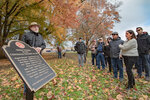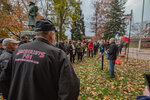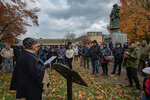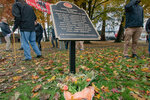



Under overcast skies, approximately 50 Industrial Workers of the World (IWW) union members gathered in Centralia’s George Washington Park for the dedication ceremony for the bronze plaque memorializing the 10 union victims of the Centralia Tragedy of 1919 on the dark day’s 104th anniversary, Saturday, Nov. 11.
The plaque is located next to The Sentinel, a statue that was dedicated in the park on Nov. 11, 1924, to the American Legion victims of the tragedy.
IWW union member Phil Reichel explained the need for the new plaque.
“To this day, this community has been scarred by this tragedy,” Reichel said. “We gather on this day, like Wobblies have for 104 years, to stand in memory of this tragedy. And this marker is a plaque to truth and justice and history.”
It was on Nov. 11, 1919, during an Armistice Day parade in Centralia following the end of World War I in 1918, when, according to some accounts, Legionnaires from the local American Legion post halted in front of the IWW’s union hall.
Tensions had been building up for several years over political and ideological differences between the groups leading up to that fateful day, and some clashes between the groups had already occurred, including a previous Legionnaire raid of an IWW union hall.
IWW members were pushing for better wages, hours and living quarters for loggers in the region’s booming timber industry.
While it is debated to this day what started the Centralia Tragedy of 1919 — also commonly known as the Centralia Massacre — four Legionnaires were killed in the ensuing skirmish and the union hall was raided again. Nine IWW members were arrested in the subsequent chaos.
Those arrested included Eugene Barnett, Ray Becker, Bert Bland, Ora Commodore “O.C.” Bland, John Lamb, James McInerney, Loren Roberts, Britt Smith and Wesley Everest.
Everest, who was drafted during the first World War and served in Washington as a logger producing timber for airplane production, never saw a trial as he was lynched the night following the battle.
Of those who did go to trial, their lawyer, Elmer Smith, was disbarred for defending them. All eight men spent at least a decade in prison.
“From the very beginning, this was a tragedy,” Reichel said. “There were witness intimidations, jury tampering, judicial malfeasance and judicial error.”
While Legionnaires claim they were peacefully marching in the parade and were attacked unprovoked, IWW members claim the Legionnaires were planning a raid on the union hall before the parade. Once the IWW members heard rumors of a possible raid, they prepared to defend their union hall, as a previous Legionnaire raid left the old hall destroyed, according to some accounts.
Union members maintain they were simply defending their union hall on that day, which is why IWW member Mike Garrison has spent at least two decades fighting to get the plaque placed in the park.
Though he’s finally got the plaque, the work for him isn’t finished.
“We’re working on the pardons now,” Garrison said.
Requests for posthumous pardons for all eight IWW union members have been sent to Gov. Jay Inslee. Reichel added the governor’s pardon committee is seeking public comment and more information for the pardons and urged those in attendance to reach out to the committee before Jan. 1 on behalf of “these workers.”
Additionally, plans are in the works for a granite base for the plaque, which he hopes to have installed by May of next year.
For more information on the Centralia Tragedy of 1919, visit https://bit.ly/3s6t1RR.